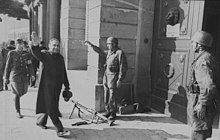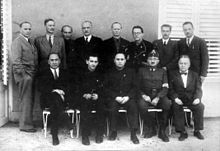Ferenc Szálasi
Ferenc Szálasi [ 'fɛrɛnʦ' sa: lɒʃi ] (born January 6, 1897 in Kaschau , Austria-Hungary , now Slovakia ; † March 12, 1946 in Budapest , Hungary ) was a Hungarian officer, fascist politician and dictator of Hungary in the final stages of the Second world war .
From 1935 to 1945 Szálasi was the party leader of the Arrow Cross Party . From October 16, 1944 to March 28, 1945 he was under the designation “Führer der Nation” (Hungarian: “Nemzetvezető”) dictatorial head of government and at the same time head of state in the parts of Hungary not yet occupied by the Red Army and collaborated with the Third Reich .
Under the Szálasi government, the second wave of deportations of the Holocaust was carried out in Hungary and death marches were organized. In addition, tens of thousands of Jews were murdered directly in Budapest . Furthermore, the actual persecution of the Hungarian Roma began , to which thousands of people also fell victim. Szálasi's takeover of power also meant that most of the Hungarian army fought on the side of the Third Reich until the end of the war, especially during the Battle of Budapest and the Lake Balaton offensive .
After the Second World War, Szálasi was executed as a war criminal in Hungary in 1946 .
Life
Szálasi came from a family with Armenian , German, Hungarian, Slovak and Russian ancestors. He was trained at the Theresian Military Academy and fought in the First World War . In 1925 he became a general staff officer. Shortly thereafter, however, charges were brought against him for revolutionary activities, as a result of which he was discharged from the army.
In 1935, Szálasi was the founder of the party of the national will , from which the Arrow Cross members emerged in 1937, a National Socialist party in Hungary led by József Gera and his secretary Lajos Polgár . When he was imprisoned for a few days for this political activity in 1937, he became a popular martyr of the Hungarian National Socialist movement. From 1938 to 1940 he served another prison term.
After the overthrow of the Reich Administrator Miklós Horthy , Szálasi was declared Prime Minister by the German occupying forces on October 15, 1944 in the part of the country not yet occupied by Soviet troops.
In these parts of the country, the Jewish population was still forced on death marches in November 1944 . On the orders of Adolf Eichmann , the German ambassador to Hungary, Edmund Veesenmayer , and the SS representative Otto Winkelmann asked the new Hungarian interior minister Gábor Vajna to transfer " loan Jews " to the Third Reich on October 17, 1944 . The next day, the new government under Szálasi agreed to provide the Third Reich with a further 50,000 Jewish men and women as slaves for the armaments industry by the end of the war. The total number of “loan Jews” delivered up to December 1, 1944 was 76,209. Most of them died either on the death march, in concentration camps or during the excavation work on the southeast wall .
Another 50,000 Jews were killed in Budapest by the murder squads of the Szálasi regime.
Szálasi and his government fled from the capital Budapest , besieged by the Red Army, to Güns near Steinamanger on the border with the German Empire. When the Soviets had occupied all of Hungary, he fled further west via Vienna until he finally surrendered to the approaching US army at Tann, together with his military command, on May 1, 1945 . Szálasi and his colleagues were arrested by the Americans and extradited to the Hungarian authorities in the same year.
Ferenc Szálasi was sentenced to death for crimes against humanity during the Second World War and hanged in public with Vajna, Károly Beregfy and Gera on March 12, 1946 in Budapest .
literature
- Martyn Rady: Ferenc Szálasi, "Hungarism" and the Arrow Cross . In: Rebecca Haynes, Martyn Rady (Eds.): In the Shadow of Hitler: Personalities of the Right in Central and Eastern Europe . IB Tauris, London 2011, pp. 261-277, ISBN 978-1-8451-1697-2 .
Web links
- “Dark chapter in Hungary's history” ( Memento of September 30, 2007 in the Internet Archive ). In: George Mason University's History News Network HNN (Eng.)
- Newspaper article about Ferenc Szálasi in the 20th century press kit of the ZBW - Leibniz Information Center for Economics .
Individual evidence
- ^ Paul Lendvai: The Hungarians. A thousand years of history. Goldmann Verlag, Munich 2001, p. 471.
- ↑ 13th Armored Division
| personal data | |
|---|---|
| SURNAME | Szálasi, Ferenc |
| BRIEF DESCRIPTION | Hungarian fascist party leader and war criminal |
| DATE OF BIRTH | January 6, 1897 |
| PLACE OF BIRTH | Košice , today Košice |
| DATE OF DEATH | March 12, 1946 |
| Place of death | Budapest |


